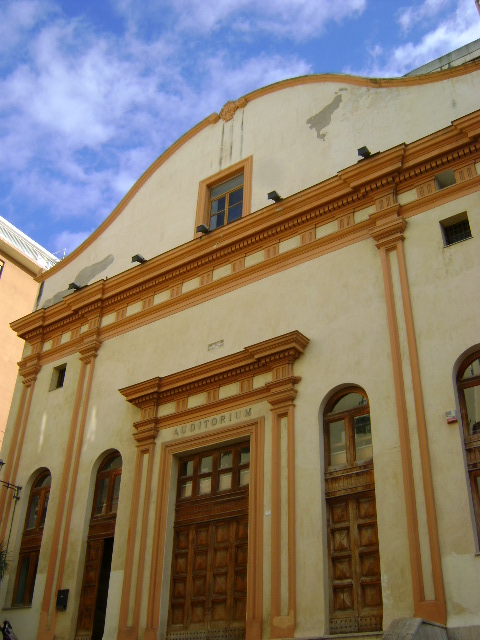Seriously damaged by bombs in 1943, the former Church of Santa Teresa (late 17th century), in the aftermath of the war was renovated and turned into a concert hall. After more renovations, completed in 1984, the venue was renamed Civic Auditorium. From 2009 to 2013, it housed the local School of Dramatic Art, directed by Lelio Lecis. Each theatre season features productions by the best Sardinian companies.
The layout of the church, very similar to the church of Santa Croce, had a single nave, on which three chapels opened on each side; the transept was contained within the perimeter while the presbytery was of the same size to that of the nave.
Today only the facade is visible of the ancient church. The interior, indeed, completely renovated between the 70s and 80s, today is home to a small theatre. The façade is cut horizontally by a classical taste entablature with a metope and triglyph frieze, which divides it into two orders. The lower order is punctuated vertically by four pilasters that frame two windows and two doors placed on the sides of the large main portal, consisting of a rectangular opening flanked by two pilasters that support the architrave with classical friezes. In line with the portal in the upper order ended in "carabiniere's lamp" there is a rectangular window. The upper crown with double spirals frames the emblem of the Company. The octagonal dome, located above the intersection of the transept with the hall, and set on a high drum on which eight rectangular windows open, is completed by a lantern.
The construction of the church, annexed to the Jesuit college (founded in 1611), can date back to a period of time from 1623 (according to a notarial act, the Archbishop of Cagliari De Esquivel ordered on this date that the bequests of the nobleman Leandro di Torres were used for the construction in Cagliari of a church in "honour and glory of Our Lord and his Blessed Mother Our Lady and under the invocation of the glorious Saint Teresa") to 1691 (inscription on the plaque embedded in the main prospect) .
The Jesuits remained there until the suppression of the Company in 1773. The complex, passed to the secular clergy and returned to the Order in 1822, in 1848, with their definitive expulsion passed to the State Property, which in 1882 proceeded to sell the goods contained in them. In 1884 the church, now deconsecrated, became the seat of the State Archive, transferred to its present location between 1927 and 1929.
In 1926 the church became the seat of the “Rionale de Fenu Group”, Italian Youth of the Littorio. In 1944 the Jesuit fathers asked the Fund for Worship to return the ancient temple, seriously compromised by the bombing, pledging to have it restored at its own expense. However, the attempt was unsuccessful. In 1947 the Superior Ministry "Intendenza di Finanza", with a private tender, rented the property. The Superintendency of Cagliari oversaw the whole affair so that the protection laid down by Law 1089 was guaranteed.
In 1949, given the disaster of the city Theatre, the church was adapted into a concert hall, while between 1950 and 1953 it was transformed by the Civil Engineers into the Auditorium of the Conservatory of Music. Between 1982 and 1984, with the elimination of the side chapels, the definitive transformation took place.
Auditorium Comunale (ex Chiesa di Santa Teresa)
Auditorium Comunale (ex Chiesa di Santa Teresa)
Piazza Dettori, 8
City
CagliariAdd new review
Your review will be visible after approval by the editors
To post a review you must be an authenticated user.
Log in with Social Login
